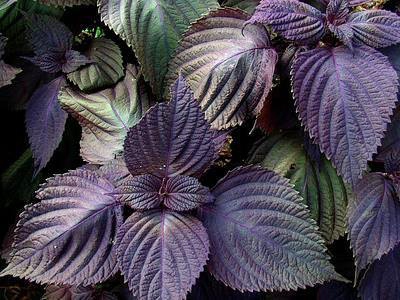Description
Details

What is perilla leaf? What is it used for?
The perilla is a purplish plant that grows throughout east Asia, especially in the hills and mountains of China and Japan. It can reach a height of approximately two feet, with scented flowers that bloom in July and August. Different parts of the perilla are used for different conditions. This article discusses the use of perilla stem; perilla seed and perilla leaf are discussed elsewhere.
Perilla leaves are warm and acrid, according to the principles of traditional Chinese medicine, and are associated with the Lung and Spleen meridians. Its functions are to dispel wind cold and regulate qi. Traditionally, perilla leaves are used to treat colds, stuffy chests and abdominal pain, to stop stomachaches and diarrhea, and to prevent coughs. Occasionally, they are used to treat morning sickness. In addition, perilla leaves can be used with other herbs to treat food poisoning caused by eating bad seafood.
How much perilla leaf should I take?
The typical dosage of perilla leaf is between 3 and 12 grams, decocted in water. When creating a decoction, perilla leaves should be boiled no longer than 10 minutes.
What forms of perilla leaf are available?
Crushed, dried perilla leaf can be found at many herbal shops, Asian markets and specialty stores. Powdered perilla leaf is also available in some locations.
What can happen if I take too much perilla leaf? Are there any interactions I should be aware of? What precautions should I take?
As of this writing, there are no known side-effects from taking large doses of perilla leaf, nor are there any known drug interactions. Women who are pregnant should use perilla leaf only under a health care provider's supervision. As always, make sure to consult with a licensed health care practitioner before taking perilla leaf or any other herbal remedy or dietary supplement.

References
- Ihara M, Umekawa H, Takahashi T, et al. Comparative effects of short- and long-term feeding of safflower oil and perilla oil on lipid metabolism in rats. Comp Biochem Physiol B Biochem Mol Biol October 1998;121(2):223-31.
- Nagatsu A, Tenmaru K, Matsuura H, et al. Novel antioxidants from roasted perilla seed. Chem Pharm Bull (Tokyo) May 1995;43(5):887-9.
- Narisawa T, Fukaura Y, Yazawa K, et al. Colon cancer prevention with a small amount of dietary perilla oil high in alpha-linolenic acid in an animal model. Cancer April 15, 1994;73(8):2069-75.
- Okuno M, Kajiwara K, Imai S, et al. Perilla oil prevents the excessive growth of visceral adipose tissue in rats by down-regulating adipocyte differentiation. J Nutr September 1997;127(9):1752-7.
- Suzuki H, Ishigaki A, Hara Y. Long-term effect of a trace amount of tea catechins with perilla oil on the plasma lipids in mice. Int J Vitam Nutr Res 1998;68(4):272-4.
Advice to consumers
Some individuals may have adverse reactions to certain plants, herbs, and other natural products.
Just because something is natural does not mean it is safe for everyone.
On any issue where no specific advice is given to consumers please follow this general advice if you are currently taking the product:
you are advised to discontinue use and consult your pharmacist or herbal medical doctor.
when speaking to your doctor of pharmacist you may find it helpful to take a copy of this MHRA advice about the product with you
you should continue to take any medication prescribed by your doctor.
Additional
Additional
| Country of origin | Korea |
|---|---|
| Health Benefits | digestive disorders, gastroenteritis, hair loss, hair regrowth, Hypothyroidism, rheumatism, treatment of infections |
| Ingredients | Natural Perilla Frutescens Leaves |
| Directions | Wash 20g of herb on running water; boil for over 2hours depending on symptom in 2L of water. |
| Storage Temperature | room temperature |
| Product Package | Loose leaf, Paper sealed bag |
| Good herbal formulation | Platycodon Radix, Dried Orange Peel |
Reviews
FAQ
Frequently Asked Questions
A: Generally you boil 20g of tea/herb with 2L. of water. The ratio does not matter. However, it is recommended that you control the
saturation of the tea (how strong it is) depending on your personal
preference and body condition.
A: It depends on the tea/herb.
For leaves: boil for 15~20 min.
For hard fruits, roots, and stems: If you soak the tea/herb in water
for 1~2 hours before boiling, you can save time in boiling, and also
get a deeper flavor than without soaking.
A: Currently, what is listed on the site is what we mostly deal with in
retail stores. However, if there is a certain tea/herb that you wish to
get, you can send an email to info@leafnflower.com. or 844-344-0622.
Then, we may offer a price for obtaining the tea/herb, answer questions, and even offer purchase.
A: Yes, you can combine 5~10g of teas/herbs that you already have with Leafnflower.com's teas/herbs.
Although brewing one tea/herb is still good, combining 2~3 teas/herbs helps bring out
the remedial effects of the tea/herbs better than brewing just one tea/herb. However, most tea/herbs contain natural toxins,
and it is recommended that you boil 1~2 pieces of liquorice root along with the tea/herb to remove the toxin.

